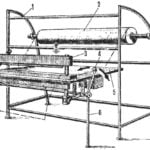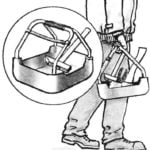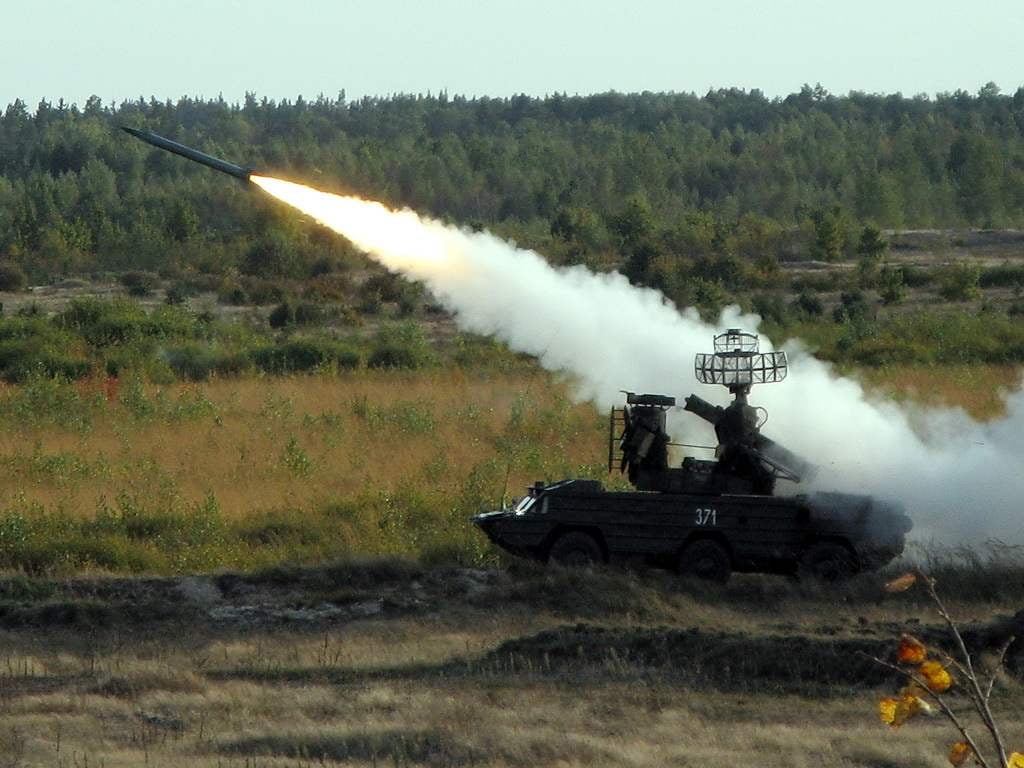 Accumulated by the end of 1950-x years experience of operation of the first anti-aircraft missile systems has shown that to combat low-flying targets they were of little use With great clarity evident when experiments began to overcome air defense systems aircraft at low altitude In this regard, several countries started research and development of compact low-altitude anti-aircraft missiles (SAMS), is intended to cover both stationary and moving objects. Requirements, device to them in different armies was in many respects similar, but, first and foremost, they equally argued that SAM should be completely automated and compact, to accommodate more than two cars of high passability (otherwise they deployed is unacceptably high).
Accumulated by the end of 1950-x years experience of operation of the first anti-aircraft missile systems has shown that to combat low-flying targets they were of little use With great clarity evident when experiments began to overcome air defense systems aircraft at low altitude In this regard, several countries started research and development of compact low-altitude anti-aircraft missiles (SAMS), is intended to cover both stationary and moving objects. Requirements, device to them in different armies was in many respects similar, but, first and foremost, they equally argued that SAM should be completely automated and compact, to accommodate more than two cars of high passability (otherwise they deployed is unacceptably high).
First like SAM was supposed to be American “the Mauler” is intended for reflection of attacks of low-flying aircraft and tactical missiles of All funds of the SAM was placed on the crawler Transporter amphibious M-113 and included a launcher with 12 missiles in containers, equipment for target acquisition and fire control radar antenna pointing system and power plant it was Assumed that the total mass of the SAM will be around 11 t, which will enable its transportation by aircraft and helicopters But at the early stages of development and testing, it became clear what initial requirements for “the Mauler” was launched with excessive optimism So created for him a single-stage missile with semi-active radar homing head with a starting weight 50 — 55 kg was to have a range of up to 15 km and reach speeds of up to 890 m/s, the Implementation of these characteristics rocketry design ideas was able to provide only 25 — 30 years owing To development were doomed to failure and in July 1965, at a cost of more than $ 200 million, from the “Mauler” was abandoned in favor of a more pragmatic implementation of PME programs, based on the use of aircraft missiles “Sidewinder”, automatic anti-aircraft guns and the results of similar research carried out by firms in Western Europe.
A pioneer in this field was the British company “Shorts”, where on the basis of studies to replace anti-aircraft guns on the small ships from April of 1958 he had begun work on rocket “Sikat” with a range of up to 5 km, This missile was to be the main part of a compact, cheap and relatively simple air defense systems In early 1959, before the start of series production, the system was accepted into service of the ships of great Britain, and then Australia, New Zealand, Sweden and several other countries in Parallel with the shipboard variant has developed ground-based version of the system with the 62-kg missile”, Tigercat”, which had a speed of 200 — 250 m/s and placed on tracked or wheeled armored personnel carriers, and on trailers. In the future, “Tigercat” was adopted in more than 10 countries.
In turn, waiting for “the Mauler” in the UK firm “British aircraft” started in 1963, work on the creation of SAM ET 316, hereinafter designated “rapier” However, its performance in almost all parameters were significantly lower charges against “the Mauler”.
Today, several decades later, we should recognize that the ideas laid down in the “Mauler”, to the greatest extent realized in the Soviet air defense system “OSA”, despite the fact that its design also was very dramatic and was accompanied by a change in as programme managers and development agencies.
SAM “Wasp”
Create 9КЗЗ SAM “Wasp” commenced on 27 October 1960 Adopted this day by government decree ordered the establishment of military and naval variants of small Autonomous s unified missile 9МЗЗ weight 60 — 65 kg This self-propelled SAM system intended for air defense forces and their facilities in the combat formations of infantry divisions in different forms of battle and on the March among the main requirements, device to “EfE” was full autonomy that would be provided accommodations fixed assets SAM — station detection, a launcher with six missiles, communications, navigation and topographic location, control, computing, and power supplies on a single self-propelled wheeled floating chassis, and the ability to detect the movement and defeat with short stops suddenly appear from any direction low-flying targets (at a range of from 0.8 to 10 km, at altitudes from 50 to 5,000 m).
The main developers was assigned to NII-20 (now NIEMI)—chief designer SAM M. M Lisichkin and KB-82 (Tushino engineering plant) — chief designer SAM A. Potepalov and lead designer M G Ollo Initial plans foresaw the completion of “EfE” to the end of 1963.
However, the challenge of reaching such high standards when available at the time opportunities, as well as a large number taken at the early stage of development of innovation has led to the fact that the developers have met with considerable objective difficulties Already in 1961 at the stage of issue of the preliminary design revealed the discrepancy of indicators of the main elements of the missile complex, developed by various organizations Trying to solve the problems, the developers have gradually abandoned some of the most advanced, but not yet secured the respective production base of technical solutions. And not out of paper or experimental stage radar detection and tracking of targets with a phased array, the semi-active radar homing missiles, combined with the autopilot in the so-called multifunction unit Last literally “scattered” missile At the initial design stage, based on the amount of the starting mass of the rocket, to KB-82 was assumed that with this unit, the weight of which was estimated at 12 — 13 kg, the rocket will have high pointing accuracy, for adequate destruction efficiency goals through warhead with a mass of 9.5 kg. In the remaining less than 40 kg had to be integrated propulsion and control system.
But already at the initial stage of the work the creators of the instrument is almost twice the weight of the multifunctional block, and is forced to move to the use of radio command guidance method, which consequently lowered the accuracy of guidance. Unreal was and incorporated in the design characteristics of the propulsion system — a 10 percent shortfall of energy required an increase in the supply of fuel. Missile launch weight reached 70 kg. To remedy this situation, to KB-82 started to develop a new engine, but time was lost.
During 1962 — 1963 Donguzskom on the ground made a series of throwing launches prototypes of missiles, and four Autonomous missile launch with a full set of equipment. Positive results were achieved only in one of them.
Caused problems and the developers of the combat vehicle of the complex — self-propelled launcher “1040”, created by designers Kutaisi automobile plant, together with specialists from the Military Academy of armored troops. At the time of its entering the trial, it became clear that its mass also exceeds the limits of.
Anti-aircraft guided missile 9М33М:
1 — radiotransparent Radome radiating antenna radio controlled fuses, the 2 front compartment with a transmitter of radio controlled fuses; 3 — aerodynamic wheel; 4 — compartment steering actuator, 5 — instrument compartment, 6 — receiving antenna of the radio Fuze, 7 — gargrot, 8 — front bracket, 9 — solid rocket motor; 10 — moving wing, 11 — fitting joining of the SRB and the instrument module; 12 — side pneumopathies; 13 — receiving antenna of the radio-tion of the line; 14 — fairing hinge Assembly wing; 15 — a back yoke; 16 — nozzle solid propellant
January 8, 1964, the Soviet government established the Commission and entrusted to provide the necessary assistance to developers “Wasp” headed by the chief of the NII-2 (now GosNIIAS) V. A. Dzhaparidze, and its members have become the most influential at that time the developers of anti-aircraft missiles And Raspletin and P. D. Grushin. The results of the work of the Commission on 8 September 1964 issued a joint decision of the CPSU Central Committee and USSR Council of Ministers, pursuant to which KB-82 was released from work on the rocket 9МЗЗ and its development was transferred to OKB-2 (now MKB Fakel) P. D. Grushina at the same time set a new deadline for the submission of SAM on a joint test — II quarter 1967.
The experiences had by the time the specialists of OKB-2, their creative search of solutions to engineering and technological problems allowed to achieve impressive results, despite the fact that the missile had to be developed almost from scratch, besides, the OKB-2 demonstrated that a demand made to the rocket in 1960, overly optimistic. Consequently, the most critical parameter of the previous task — the mass of the rocket — almost doubled.
Specifications and features of the new missile and modified for different elements of the complex presented in the preliminary draft, released in the same year 1964. Quick to prepare this document was due to the fact that the study on 9МЗЗ rocket at OKB-2 was started a few months before the official transfer of the topic. We used the rich scientific and technical potential, accumulated during more than a decade of successful development of anti-aircraft missiles for s-75, s-125 and M-1.
Among others, applied and innovative technical solution. In those years it was known that low-altitude maneuvering rockets the most suitable aerodynamic configuration “duck” with a front rudder. But the indignant rejected rudders airflow then worked on the wings, giving rise to undesirable perturbations in the roll, the so-called “moment oblique blasting” With it in principle impossible to handle by the differential deflection of the rudders for roll control. Had to install on the wings and ailerons, respectively, to complement the rocket additional actuator. But for a small rocket excess volumes and reserve mass for them.
P. D. Grushin and his staff ignored the “moment oblique blasting”, allowing a free rotation roll, but only the wings, not the entire rocket pack wings secured to the bearing Assembly, the moment is almost not transmitted to the body of the rocket.
In the design of the rocket was first used advanced high-strength aluminum alloys and steel, three front compartments with the equipment to ensure proper sealing done in the form of a single welded unit. The solid-fuel engine — a dual-mode. Located at nozzle block telescopic dual channel charge of solid fuel created while burning maximum traction at the launch site, and a front charge with a cylindrical channel — moderate thrust in propulsion mode.
The first launch of a new version of the missile took place on 25 March 1965 and in the second half of 1967 “ASU” presented at the joint state tests. On the Emba polygon has identified a number of fundamental flaws, and in July 1968 the test was suspended At this time, among the main shortcomings of the customers pointed to the unfortunate layout of the combat vehicle with spaced housing elements of SAM and its low maintenance characteristics. The linear arrangement of the starting device SAM and the antenna post of the radar at one level exclude the attack low-flying targets behind the machine, at the same time the starter significantly limits the field of view of the radar front of the car, as a result of the “object 1040” had to be abandoned, replacing it with a load-lifting chassis “937” Bryansk automobile plant, which was able to constructively combine into a single device, radar and launcher with four missiles.
The new chief designer of “Wasp” was appointed Director NIEMI, V. P. Efremov, his Deputy — And M. drize. Despite the fact that “the Mauler” by the time stopped, the developers of “Wasps” was still determined to bring matters to the end. A big role in his success was the fact that in the spring of 1970 on abinskom the range for preliminary (and additional live-fire testing) assessment of the processes of functioning of the “Wasps” have created a semi-natural modeling system.
Since July, began the final stage of testing, and on 4 October 1971, OSU was adopted in Parallel with the final stage of state tests the developers of the complex have begun to modernize air defense system, with the aim of expanding poradami areas and enhance the combat effectiveness (“OSA”, “OSA-AK” with a rocket 9МЗЗМ2) the Most significant enhancements to the SAM at this stage was increasing placed on the military machine of the number of missiles in transportorului containers up to six, improving the noise immunity of the complex, increasing the service life of the rocket, lowering the minimum height to engage targets up to 27 meters
In the course of further modernization, which began in November 1975, SAM received the designation “OSA-AKM” (rocket 9МЗЗМЗ) its main advantage has been the effective defeat hanging out and flying at almost zero altitude helicopters and small UAVs. These qualities “OSA-AKM”, adopted into service in 1980, acquired earlier than the later of its counterparts — the French “Krotal” and Franco-German “Roland-2”.
Soon the “Wasp” was first used in combat In April 1981 in the reflection air strikes on Syrian troops in Lebanon, the SAM missiles shot down several Israeli aircraft. The high efficiency of SAM “Wasp” was maintained even in conditions of intensive jamming, which was forced to deal with it, along with EW, use a variety of tactics, in turn, reduces the effectiveness of the strike aircraft.
Further the high characteristics of different variants of SAM “Wasp” and its naval variant, “OSA-M” was able to assess and military specialists from almost 25 States where at present these SAMS are in service of the Latter, as it is the only effective weapon that according to the criteria of cost and efficiency still remains among world leaders, was Greece.
Characteristics of the missile 9МЗЗМЗ
The affected area in range, km…………………………1,5 – 10
The affected area height, km………………………………0,025 — 5
The maximum speed of the targeted objectives, m/s……up to 500
The mass of the rocket, kg………………………………………………….127
The mass of the warhead of a rocket, kg……………………………..14,5
The average velocity of the rocket on the trajectory, m/s……….. 500
V. KOROVIN, Vladimir MINAKOV
Recommend to read
 TUNGSTEN – the little TAILOR
TUNGSTEN – the little TAILOR
Simple machine for the manufacture of a protective "shirt" to a milking apparatus. prepared for transportation created by the innovators Yanovskogo district Association of Lithuania.... THE TRAY UNDER THE HAMMER
THE TRAY UNDER THE HAMMER
If you want to transfer a set of tools to the job site or just keep them at the ready is essential for this will be an easy plastic tray. These are found in hardware stores, but can be...
 Accumulated by the end of 1950-x years experience of operation of the first anti-aircraft missile systems has shown that to combat low-flying targets they were of little use With great clarity evident when experiments began to overcome air defense systems aircraft at low altitude In this regard, several countries started research and development of compact low-altitude anti-aircraft missiles (SAMS), is intended to cover both stationary and moving objects. Requirements, device to them in different armies was in many respects similar, but, first and foremost, they equally argued that SAM should be completely automated and compact, to accommodate more than two cars of high passability (otherwise they deployed is unacceptably high).
Accumulated by the end of 1950-x years experience of operation of the first anti-aircraft missile systems has shown that to combat low-flying targets they were of little use With great clarity evident when experiments began to overcome air defense systems aircraft at low altitude In this regard, several countries started research and development of compact low-altitude anti-aircraft missiles (SAMS), is intended to cover both stationary and moving objects. Requirements, device to them in different armies was in many respects similar, but, first and foremost, they equally argued that SAM should be completely automated and compact, to accommodate more than two cars of high passability (otherwise they deployed is unacceptably high).




